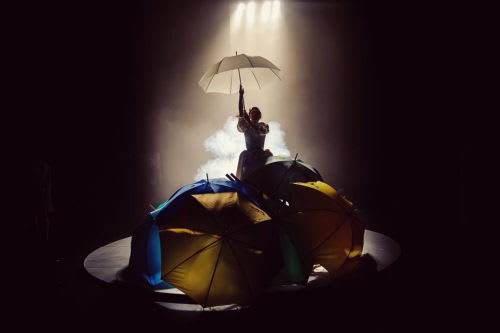Dukes’s staging of Marlowe’s tragedy is pared down to an admirable simplicty. He plays it on a simple cream disc set against blackness, or backed by a misted veil of light and adds colourful umbrellas to create an arbour at the opening that will part to reveal Jupiter buggering Ganymede at the end of the introductory prologue.
This scene of celestial abandon is untypical of the overall production with Harper James’s slightly queeny Ganymede producing a telephone to enable the King of the Gods to issue orders. The rest of the performance is more formal and stylized, a pattern set at the start with the sound of waves lapping holding the audience in anticipation before being joined by the whole company chanting as they slowly enter and circle the stage, two figures—are they gods or humans?—taking tiny model boats from the top of the umbrella façade and circling with them on their outstretched palms through the golden beams of Rachel Smith’s lighting.
Aeneas and his men, having fled the sack of Troy and following the instruction of Jupiter, are on their way to Italy to found the city of Rome when their fleet is damaged by storm off Carthage. There they appeal for help from Queen Dido who, controlled by Venus and Cupid, falls in love with Aeneas and rejects her suitor Iarbus, King of Gaetulia. This love Aeneas returns but, ordered by Jupiter, deserts.
Dukes clearly feels the romantic element of the play needs strengthening for he inserts, not once but three times, the well-known verses from Marlowe’s poem The Passionate Shepherd; “Come live with me and be my love.” He gives them first to Dido’s suitor, then has them sung by Aeneas' small son Ascanius (rather awkwardly represented here by a puppet figure), and then has them sung as an accompaniment when Dido and Aeneas escape their followers to their love in a cave.
Until this scene, the production does not really engage the audience but now it becomes intense with feeling. Relying on physicality rather than text as they approach and retreat from each other until finally they draw together and their lips meet, a pavane-like approach to passion so different from the frantic fornication of Jupiter and his catamite.
This company has a reputation for its physicality but it is less obvious in this production apart from some obscure business with a long strip of cloth and the clever use of umbrellas that culminates in Dido’s final immolation, which makes this portrayal of passion especially effective.
This throws the emphasis, as it should, on Marlowe’s text. What Ben Jonson referred to as Marlowe’s “mighty line” poses a challenge to modern actors unused to handling such verse with its long-thought lines. In this company, only Robin Holden’s Iarbus seems to have the measure of it.
Lines are broken up into phrases, odd words shouted out, often with an emphasis that does not match overall sense. These seem lines learned rather than coming new-minted by the characters. A barrage of words that challenges audience comprehension is often accompanied by an excess of elbow-angled gesture, though in the case of Alice Brown’s Dido the physicality creates an interesting characterisation.
This is no stately queen but a young woman with a girlish lack of control, bobbing backwards and forward in her jerky gestures; it is a reading that grows from the text. Then, as the play draws to its close, aided by a costume change that gives her a different line, she gains in gravity and presence.
In fact from that climatic moment in the cave, Joseph Tweedale’s Aeneas and the whole company seem to come to grips with the verse and their communication with the audience is helped by stronger lighting. Earlier the chiaroscuro of Rachel Smith’s very directional beams creates some beautiful effects but, unless the cast are very bad at finding where their light is, it does need more front light on their faces to help them.
There seems little awareness of the richness of Marlowe’s language (in contrast to the way in which “Come with me” celebrates it). More attention is needed to the sense of what is said, though enough comes over to tell the story; there are times in the earlier scenes where audience attention falters.
Perhaps it needs time for the cast to gain confidence in handling this material and stop rushing at it, to bring that quality to the whole work that the later scenes exhibit, and make this whole production as effective.
